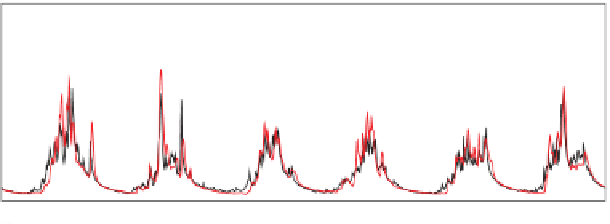Geography Reference
In-Depth Information
Figure 11.84. Hydrographs
illustrating YHyM performance at
various locations within the Mekong
River basin.
0
10
20
30
40
15000
Chiang Sean
10000
5000
0
0
10
20
30
40
50
25000
Luang Prabang
precipitation
20000
15000
estimated
10000
observed
5000
0
0
10
20
30
40
50
25000
Vientiane
20000
15000
10000
5000
0
1985
1986
1987
1988
1989
1990
Discussion
In this study we present a case study of hydrological
modelling in the large, international, poorly gauged
Mekong River basin. With the rapid increase of popula-
tion in the basin, understanding the basin
addition, the model accuracy (discharge and potential
evaporation) at selected internal points of the basin is also
reasonable, signifying that YHyM can achieve equal accur-
acy at each point in the basin, which is extremely important
in water resources planning and management. This sug-
gests that YHyM is a useful tool for addressing some of the
issues identified by the PUB initiative.
The use and development of YHyM is now being
extended jointly by the University of Yamanashi and other
institutes, especially UNESCO-ICHARM. The main area of
extension is the global application of the model to assess the
impacts of climate change on floods and to enable real-time
monitoring of flood occurrences throughout the world.
YHyM is supported by a dense global coverage of stream
networks and the combined use of observations, satellite
information and modelled rainfall data. YHyM is becoming
a hydrological simulation tool, useful for both research and
teaching, that is applicable for flood forecasting and water
resources planning and management in basins at any tem-
poral and spatial scale located anywhere in the world
shydrologyis
important for planning future water resources, protecting
its extremely diverse and complex ecosystem, and flood
mitigation. However, hydrological modelling in the
MRB is challenging due to poor data observation net-
works that are at least partially a result of the MRB
'
s
trans-boundary nature. Thus, conceptual hydrological
models are likely to fail in this situation, while distrib-
uted hydrological models combined with PUB principles
may be more appropriate. Most of YHyM
'
s parameters
are derived using the physical catchment characteristics
such as the elevation, soil properties and land cover
properties. Thus, the number of parameters that require
tuning is parsimonious and the regionalisation of param-
eters is possible.
Overall performance of the YHyM model applied to the
MRB is good and the detailed analysis on the variation of
soil moisture, evapotranspiration, interception evaporation
and runoff estimations indicates that the YHyM replicates
the natural hydrological responses of the basin well. In
'
thus
enabling monitoring of extremes and better understanding
into potential trends or changes to hydrological conditions
and water availability under different basin management,
land use or climate change scenarios.
-






























































































































































































































































































































































































































































































































































































































































































































































Search WWH ::

Custom Search